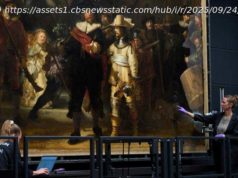What was it like in a Nazi concentration camp? How did you survive? How has it affected your life since?
By KAREN MATTHEWS, Associated Press
NEW YORK — What was it like in a Nazi concentration camp? How did you survive? How has it affected your life since?
Technology is allowing people to ask these questions and many more in virtual interviews with actual Holocaust survivors, preparing for a day when the estimated 100,000 Jews remaining from camps, ghettos or hiding under Nazi occupation are no longer alive to give the accounts themselves.
An exhibit at the Museum of Jewish Heritage in New York City called « New Dimensions in Testimony » uses hours of recorded high-definition video and language-recognition technology to create just that kind of « interview » with Eva Schloss, Anne Frank’s stepsister, and fellow survivor Pinchas Gutter.
« What we’ve found is that it personalizes that history, » says concept designer Heather Smith. « You connect with that history in a different way than you would just seeing a movie or reading a textbook or hearing a lecture. »
The project is a collaboration between the Steven Spielberg-founded Shoah Foundation, which has recorded nearly 52,000 interviews with Nazi-era survivors, and the Institute for Creative Technologies, both at the University of Southern California. First conceived in 2009, such exhibits have been put on in different forms at other museums, using technology to pull up relevant responses to questions about life before, during and after Adolf Hitler’s murderous Third Reich.
Like Anne Frank, Schloss and her family went into hiding in Amsterdam but were betrayed and sent to Auschwitz. She was eventually liberated by the Russian Army in 1945. The 88-year-old Schloss, whose mother married Frank’s father, Otto Frank, in 1953, lives in London and has told her story in talks to schoolchildren and in books including « Eva’s Story: A Survivor’s Tale by the Stepsister of Anne Frank. »
Asked about Frank, whom she knew as a child before both went into hiding, Schloss’ image says, « Anne was really a very sophisticated little girl. »
Both Schloss and Gutter sit in red chairs and speak from large flat-screen monitors.
The on-screen Gutter, who in reality is 85 and lives in Toronto, was asked « What do you do for a living? » during a museum visit last week. He answered, « At the moment I am retired. I do a lot of community social work. I’m a cantor in my synagogue. I visit people in hospitals. …. basically I do community social work as a volunteer. »
Asked about surviving a Nazi death march, he said, « We marched for two and a half weeks. And only half of us arrived at Theresienstadt. The rest were either killed or died on the road. »
Gutter will also sing a Jewish liturgical song or tell a Yiddish joke if prompted.
Smith says that, for now, the virtual Gutter is better at answering questions than the virtual Schloss because his database contains 20,000 questions to her 9,000. But she says the virtual Schloss will likely improve when asked more questions.
Smith said the material could eventually be presented in a variety of formats including holographic technologies still in development.
« The vision was to ultimately have a classroom of kids or one child or one adult actually in a room and sitting across from a Holocaust survivor and I wanted them to feel as if it was as real as possible, » she said.
Barbara Kirshenblatt-Gimblett, chief curator of POLIN Museum of the History of Polish Jews in Warsaw, said she visited the Gutter-Schloss exhibit and she hopes that future technological advances don’t overshadow the survivors themselves.
« However innovative the technology is, it is not at the foreground of the experience, and it shouldn’t be, » Kirshenblatt-Gimblett said. « What’s beautiful about this installation is that the survivors are front and center, they are charismatic and what they have to say is utterly compelling. »
_____
AP Investigative Researcher Randy Herschaft contributed to this report.
___
Online: http://mjhnyc.org/exhibitions/new-dimensions-in-testimony






